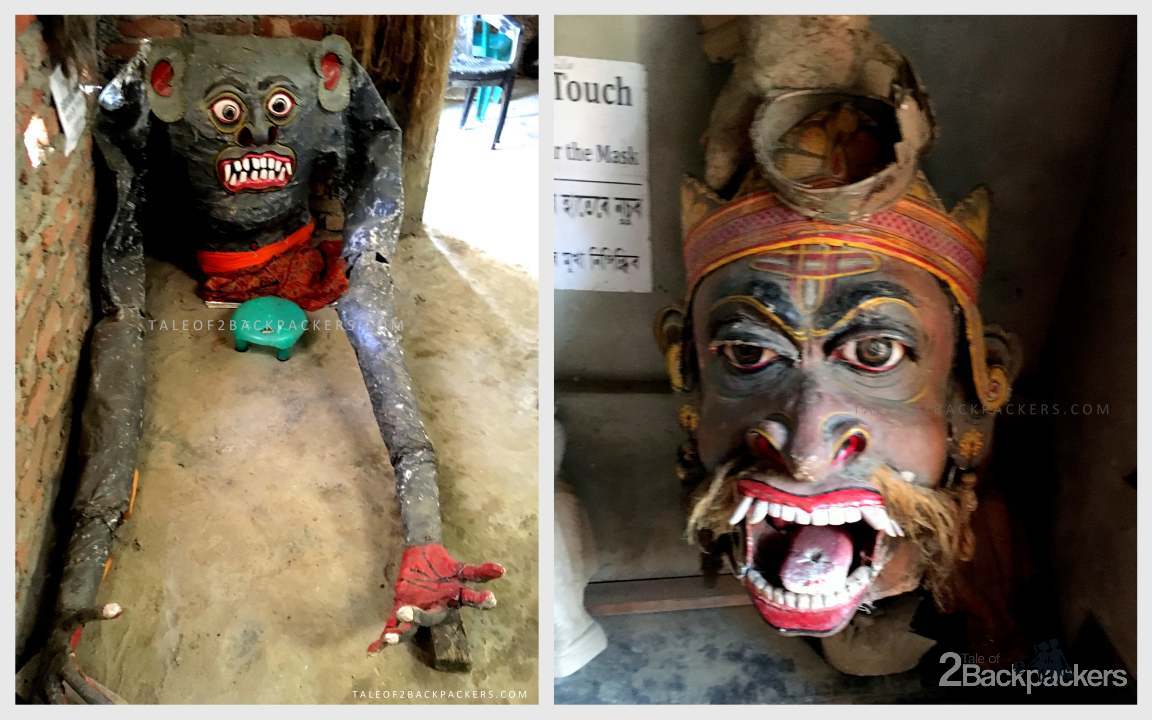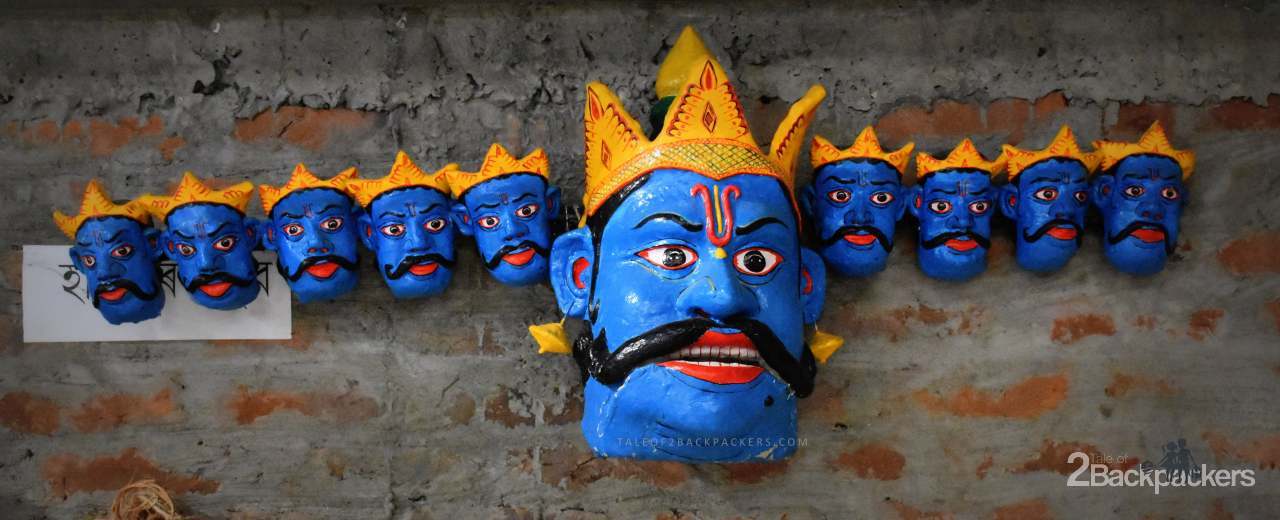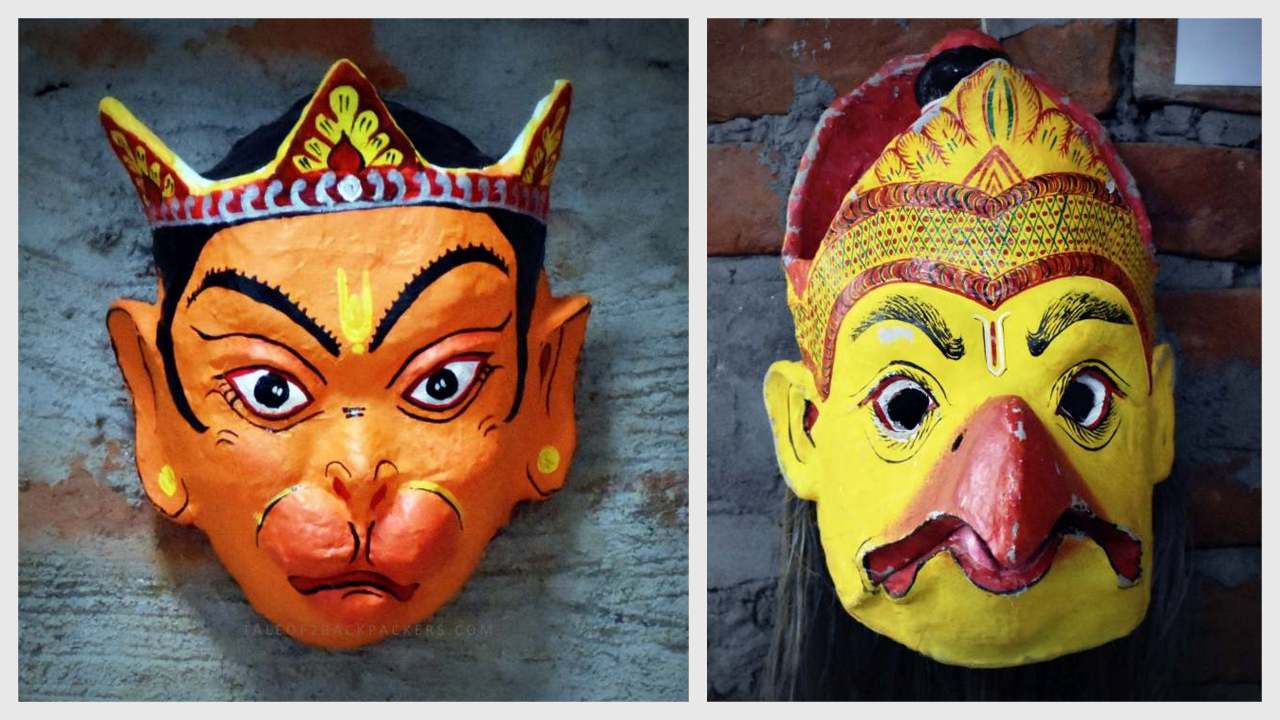In the days of yore, the people of Majuli heard a loud voice from the Brahmaputra. The unknown voice kept on repeating ‘Banhtote kathito, jopatote pachito’. It meant ‘you will get a piece of split from a bamboo and a basket from a bamboo grove’. The voice urged them to learn the skill and art of mask making. And perhaps this is how masks of Majuli had become such an integral part of the culture of Majuli.
As we stood in a room full of decapitated heads looking at Kabandha, the hideous headless demon who had his eyes and mouth on his stomach; we listened raptly to the tales of Bhaonas, Satra and the masks of Majuli.

Masks of Majuli – The Heritage
Apart from being the largest riverine island in India, Majuli is synonymous with the practice of Neo-Vaishnavite tradition and culture that has been nourished here with great love and devotion. Although it is the largest riverine island in India and perhaps in the world too (there is a slight controversy regarding this), Majuli is a disappearing island.
After all, Sri Shankaradeva was a visionary. His philosophies had transcended the boundaries of religion and culture and today Majuli is one place where devotion has mingled with art in a unique way. Shaped by his philosophies, the Satras (or Xatras) of Majuli are a Vaishnavite ashram, which apart from being a platform for religious discourses are also centres for imparting cultural and creative knowledge.

Sri Sankaradeva wanted a social change and not just any new form of religion without the elaborate rituals of the erstwhile. He used his expertise in the medium of performing arts to get his message to the commonest men. He wrote plays on the life of Lord Krishna and performed traditional theatres called Bhaona and song and dance performances in the villages. In such Bhaona performance, masks were used by the performers to depict the characters of the play. Earlier the masks were made of different materials like wood, clay and earth. Later bamboo was used to make these masks. The masks made of bamboo were naturally quite lightweight.

These masks thus became a medium to present the events in the Vaishnavite scriptures and in the Bhaona performance and gradually mask making developed into an important craft of the area. And the Satras were the places where the masks were made. The voice of Brahmaputra finally laid to rest!
Masks of Majuli – The Present:
At present, all the Satras of Majuli do not practice the art of making masks. The art has been kept alive at the Nutan Chamaguri Satra. We visited the Satra and the first place we entered was a room filled with masks – big and small. They depicted various mythological characters and it reminded us of all the childhood stories of Mahabharata and Ramayana.

The Satradhikari (Head of the Satra) Hem Chandra Goswami is a master craftsman. He has kept the art of mask making alive and also thriving. Winner of National awards, he also happens to be a great storyteller. Unfortunately, we did not meet him as he was away in Delhi where the Masks of Majuli would be on display at the Republic Day Parade. Instead, we met Prasanna Goswami, who was more than happy to share his stories with us.


Mask making is an elaborate process. It begins with making a three-dimensional framework for the face. It is made from a local variety of bamboo that is cut into splits. These splits are then used are woven into a hexagonal pattern to make the framework. The woven base is now covered with pieces of cotton fabric dipped in a paste of clayey soil and water mixed with cow dung. This paste is applied over the mask for a number of times as per requirement and then facial features are carved out on each of the wet frames using a special set of knives. The pieces are then dried in the sun. Natural colours were earlier used for beautification of the masks. But now, artificial colours from the market are used. Hair and mustaches are made from jute and water hyacinth.Only after these meticulous steps, the masks are then ready for Bhaona performance.



The masks are of three types – Mukha (these are only the face masks). Lotokai Mukha (in this type of masks, eyes and lips can be moved) and Bor mukha (these are big in size and covers almost the whole body).
We saw Ram, Sita, Ravana, Narasimha and as mentioned before the hideous Kabandha. There were a few other masks of demons as well. Nowadays, they are also making small masks that are bought the tourists as souvenirs. Many foreign tourists are nowadays leaning the art of mask making too. Tourism is changing the place for good.






When I decided to play Sita!
Having seen the Gomira and Chhau performances before, we wanted to see a Bhaona now. Both Gomira and Chhau also use masks as a part of the performance. The masks used in all these three dance forms are different, their dance techniques also differ, but there is one thing that unites all these art forms. The devotion of the dancers while they perform are incomparable and the theme of victory of good over evil always pervades.
To know more about Majuli, read our Majuli Travel Guide.
And in the meantime, take a glimpse of a Bhaona performance.
Liked the post? Please like it, share it and comment. Pin it for a later read.



Interesting blog on Majuli island. I was there in Assam last December and Majuli was so cold. Loved the local food there. Satras are so interesting. Thanks for the share.
Pictures are very interesting and I would like to visit Majuli one day. Still it’s not so high on my bucket list. But I read nice tips about it and this will help me to be well prepared for sure.
Nice! The place looks interesting..:D Next time when i have to buy masks i will give a visit to Majuli.
It’s really cool that you decided to learn the story behind the Majuli masks. Very often, we enjoy cultural performances and aspects of a place without diving deep into the elements of it. The Majuli masks look pretty awesome, although some of them are really scary but that only goes to show how amazingly they’ve been done. Mask making skill isn’t something I had thought would be so complicated but when I started to read your description, I realised its not as easy as I had imagined. I’m sure it was bit disappointing to miss the master of mask making- Hem Chandra Goswami, but you still learned a lot. Thanks for this informative post!
Thanks Medha! Yes, we were a bit disappointed as we could not meet Hem Chandra Goswami, but the experience was awesome!
I would like to watch all three types of dances. This is very interesting. All three dances with a focus on storytelling is amazing. These masks are so colorful and expressive.
I love how art has been part of longstanding tradition of passing down knowledge or beliefs over numerous generations. this has been a great example of that. it would be a delight to see a performance like this.
Thanks Justine! The Satra has done quite a good work at keeping their tradition alive.
I had never heard of this mask making event before. Sounds so interesting. I can’t believe how much work goes into them before they are ready for the performance.
The masks looks Amazing!
I Aman Gupta from Unitedworld institute of design is going to visit Majuli island for studying and observing the ethnic community groups living there . Our main purpose is to learn about there story telling medium and to showcase all our research in a well known Chitrakatha exhibition conducted by National Institute of design in Shillong . We will be visiting Majuli on 16-17 February .
We are students from north – west part of India ,that why we are contacting you to get help from you for documenting about these ethnic communities and to make Other people aware about their culture and believes .
As we are from Gujarat, we also have communication problems, the language which we know is English and Hindi and we are also searching for accommodation around those ethnic group.
Looking Forward to hear from you and for great help !
We contacted you because we know a institution can understand students word !
Thank You !
Aman Gupta
Unitedworld institute of Design
Student
Animation And MotionGraphics
7877366151
Thank you for connecting with us Aman. We will contact you with the answers.